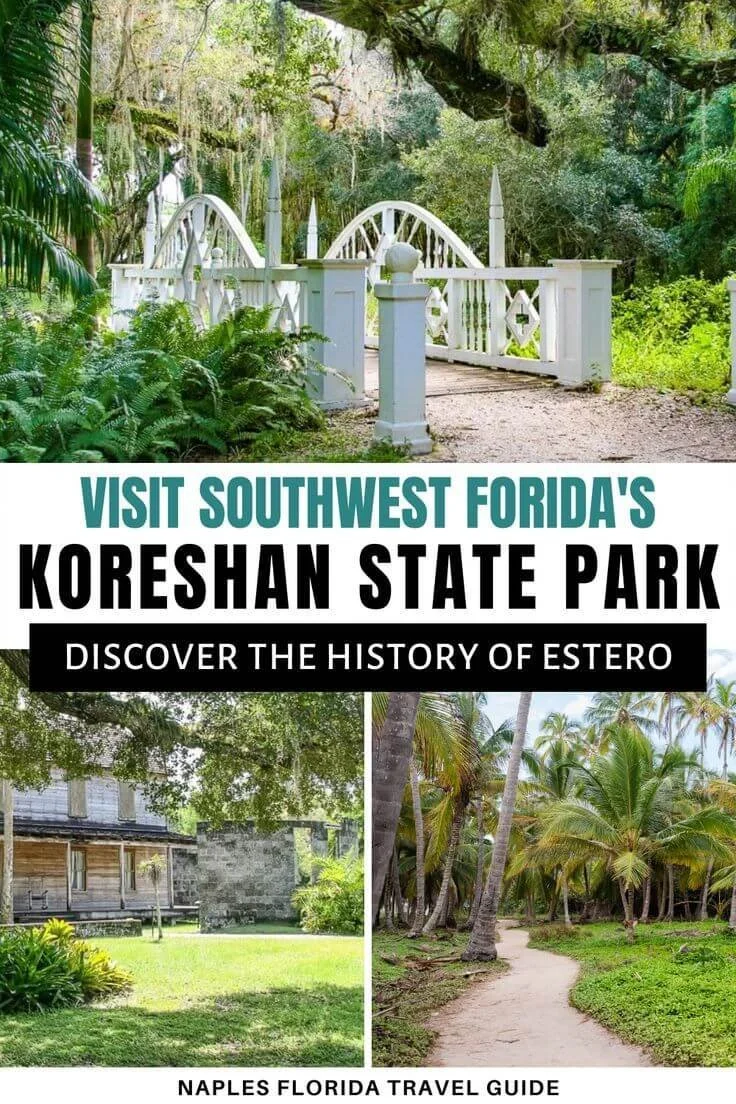Koreshan State Park: The Hollow Earth History Of Estero Florida
If you love a good history lesson, you need to visit the Koreshan State Park in Estero, an historic site and State Park in southwest Florida with some of the region’s most fascinating history!
In the late 19th century, when most of south Florida was still a harsh swampland, a group of intrepid spirits followed a New York physician to southwest Florida because they believed he was a Messiah, and the Earth was hollow, and that they lived inside.
It's a wild tale, if only it were fiction.
But this is a true story, made even fascinating when you visit the Koreshan Park in Estero, and see this nugget of amazing history for yourself.
It’s not one of the more popular and touristy things to see in southwest Florida, which is an another good reason to visit.
If you’re planning a day trip to visit some of the more quirky sites around southwest Florida, spend an afternoon away from the beaches and explore the site.
Today, the site is a lovely Park and a great place for easy light hiking.
Interestingly, it also has one of the nicest campgrounds in Naples and Fort Myers, and it’s a great place to go kayaking as well — the Estero River runs right past the site to Estero Bay and beyond to Lover’s Key.
Besides the overnight camping in the Park, there’s also a weekly farmers market with local vendors and growers.
When it comes to little-known Florida history — American history — Koreshan State Park and Historic Site is a must-see.
We guaranteed you won’t find anything like it anywhere else in the area.

Koreshan State Park and Historic Site
Koreshan State Park
The fascinating history of the Park, also called the Koreshan State Historic Site, lies in the small town of Estero, between Ft. Myers and Naples on the southwest coast of Florida.
It's worth a day trip from your beach vacation not just for its interesting history but because much of the Koreshan Unity Settlement is still there and well preserved, which makes it that much more compelling.
What comes to mind when you hear the word "Koreshan"?
If you’re like me, it conjures up odd feelings of suspicion, fear, and judgement from the sensational media story of the 1990’s about a group of religious cultists in Waco, Texas called The Branch Davidians.
They were in the news in 1993 for stock-piling weapons and explosives, and barricading themselves inside a secluded compound.
When the U.S. government raided the compound, 78 of the cult members died in the ensuing explosions, along with their leader, Vernon Wayne Howell, aka David Koresh.
Howell adopted the name Koresh, after the Hebrew name given to Cyrus the Great, a Persian king.
Like Jim Jones in the late 1970’s and countless other cult leaders through the ages, David Koresh, believed himself to be the Messiah.
This history was always in the back of my mind as I drove past the small brown State Park every day sign during that time.
I always wondered about the name, but never actually visited the site until years later.
The history of Koreshan State Park is some of the most fascinating history in Florida. Not only is it a must-visit to learn about the history, but it’s also a great place to hike, see more of Florida in its natural state, and even attend the weekend Farmers Market and other events held here throughout the year.

Washingtonian palms at Koreshan State Park

Hiking trail at the Koreshan State Historic Site
History of Koreshan Unity Settlement
The story of Koreshan Unity Settlement is unique, but bears some eerie resemblance to the modern day Messianic story in Texas.
Founded in 1894 by Dr. Cyrus Teed, an unconventional physician from Utica, New York, though he actually graduated from the Eclectic Medical College of New York, which was later considered fraudulent and declared defunct.
Teed was known to have a fondness for women.
In fact, several women moved with Teed to Estero without their husbands.
He began calling himself Koresh and in 1869, claimed divine inspiration — or what he called his “illumination” after an alchemic experiment in his lab went awry — proposing a new set of scientific and religious ideas he called Koreshanity.
This new philosophy embraced the ‘Hollow Earth’ theory which asserts that the Earth and sky exist inside the inner surface of a sphere.
Essentially, that we live inside the Earth rather than on the surface.
When his ideas didn’t gain much traction in New York state, he moved his family to Chicago where he gained a stronger following of roughly 150 people.
It’s unclear just why he left Chicago, but eventually he and his group went in search of an isolated location away from public scrutiny.
In 1894, the group landed in remote Estero, Florida, on the southwest coast of the state between Fort Myers and Naples, and created the Koreshan Unity Settlement.
And remote it certainly was.
There was nothing here in 1898 but a thick swamp and no town of Estero to speak of.
The settlement sat along the dirt road (now Rte. 41) that ran between Ft. Myers and Naples.
Teed’s grand vision was to create “The New Jerusalem”, a home for 10 million people, though the original settlement was only around 300 acres of swampland.
The settlement was founded on his beliefs of alchemy, the Hollow Sphere theory, reincarnation, celibacy, and communism or communal living - each according to his ability and needs.

Cyrus Teed, founder of Koreshan Unity Settlement
Koreshan State Park Today
The Koreshan State Park makes a great day hike and has a lot to explore.
There are roughly a dozen buildings still intact and staged for visitors, and most are open to the public, either with a docent or left open with glass partitions restricting access but offering good views inside.
The Planetary Court, Arts Center and other buildings may not always open if they are short of volunteers that day, but you will likely find at least one docent onsite who is friendly, knowledgable, and eager to share history and even a glimpse inside.
The circa 1890 Steinway piano in the Arts Center is rare and worth seeing.

The Founder’s Home at Koreshan State Park
Koreshan State Historic Site
It’s fascinating to imagine what the first Settlement members endured to follow a dream because south Florida, in its natural state, is an extremely harsh environment.
It's a swamp, even today.
The Everglades ecosystem encompasses this entire region, and there's an abundance of crawling and biting ticks, mosquitos, scorpions and venomous snakes.
It’s also home to incredible wildlife such as black bears, panthers, and lots of alligators.
For the first year, the Koreshans lived exclusively in tents, through torrential rains and ensuing mud, hurricanes, and intense Florida heat and sun.
According to letters and other documents, for their first winter they subsisted solely on peanuts.
Say what you will about cults and gullibility, but this was an intrepid group — at least the ones who stuck it out — who toiled day and night to build their New Jerusalem.
At its most successful and cohesive, the Unity Settlement had 250 members and had built homes, an Arts Center, bakery, general store, power station, workshop, and printing house.

Hollow Earth Theory model at Koreshan State Park

There was even a Performing Arts Hall at Koreshan Unity Settlement
Residents held regular theatrical performances and encouraged well-roundedness in their children, which included apprenticeships at the bakery and other vocations at the Settlement.
The Koreshans were also credited with incorporating the town of Estero, which was over 100 square miles and one of the largest incorporated towns in the country at the time.
Religion or spiritual beliefs/non-beliefs aside, the Koreshan Unity Settlement is intriguing on many levels.
Considering that Teed espoused peaceful living and considered himself a sort of Prophet, there seems to be nothing pointing to the usual deviance, abuse, or hypocritical shortcomings that typically emerge with those who think they’re the Messiah.
If there was, it's unlikely it was reported or recorded.
By all accounts, Teed appears to have been in earnest about creating a genuine Utopian society.
But what was the ultimate cost to the ones who followed him here?
Whether you believe this was a religious cult or the start of something better, the Koreshan State Historic Site is an interesting place to visit, even if simply to enjoy a view of old Florida rarely seen anymore.
But the historical significance is undeniable and by all means worth a much longer look

Fascinating history at Koreshan State Park
Koreshan State Park Camping
Located adjacent to the buildings of the Historic Site, the Koreshan State Park Campground is just a short 1/2 mile hike away through a bamboo forest along the river.
The terrain in the Park and around the surrounding trails offer easy hiking.
The trail eventually leads to the 60-site campground, all with electricity and water, picnic table and fire ring.
12 campsites are designated for tents only and are located next to the Estero River, and 4 paved ADA campsites are also available.
You can fish, canoe and kayak in the Park, and canoes are available for rent.
What Became of Cyrus Teed?
Cyrus Teed died in 1908, two years after suffering injuries in a physical altercation with a Fort Myers marshall.
In 1921, a hurricane destroyed his tomb on the southern end of Estero island and washed his coffin out to sea.
In 1961, the last remaining members donated the Unity Settlement to the State of Florida for use as a State Historic Site.
It was named to the National Register of Historic Places in 1976.
IF YOU GO
Koreshan State Park, FL - 3800 Corkscrew Road, Estero, FL 33928, FloridaStateParks.org
Hours: The park is open daily, 365 days a year from 8:00 AM until sunset. The historic settlement is open daily from 8:00 AM until 5:00 PM.
Fee: $5.00 per vehicle. Limit 2-8 people per vehicle, $4.00 Single Occupant Vehicle, $2.00 Pedestrians, bicyclists, extra passengers, passengers in vehicle with holder of Annual Individual Entrance Pass.
There are many stories and accounts on the Koreshans of Estero to delve into further - written both from outsiders looking in and direct descendants of the followers.
Want to learn more? Here are a few helpful resources:
Estero Island Historic Society
Have you been to the Koreshan State Park?
What did you think of this unique history of southwest Florida? Leave a comment blow.


Categories
Recent Posts











